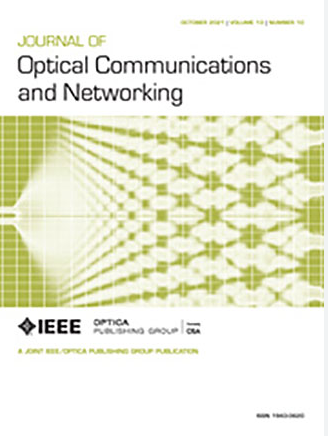50G-PON环境下的模拟前馈均衡器优化
IF 4.3
2区 计算机科学
Q1 COMPUTER SCIENCE, HARDWARE & ARCHITECTURE
引用次数: 0
摘要
我们解决了50千兆无源光网络(50G-PON)实现的挑战之一,该挑战是由低成本组件的有限带宽和光纤传输和光子器件的信号畸变引起的。在宽带接入网的背景下,更具体地说,50G-PON,最简单和最经济的解决方案通常是最好的。实现模拟前馈均衡器(AFFE)并不像使用数字前馈均衡器(DFFE)技术那么简单,但从成本和能耗的角度来看是相关的。由于它避免使用模数转换器(ADC),因此AFFE具有许多优点,例如更低的功耗和更低的延迟。在这项工作中,我们专注于AFFE优化技术,以减轻符号间干扰(ISI)和色散(CD),从而提高信号质量。为了将一个复杂的问题(例如,由于AFFE的细胞间非均匀性和细胞内非线性)简化为一个更简单的公式,可以根据最小均方误差(MMSE)方法来解决。当传输信道不波动时,这种方法是可行的。通过电气和光学设置的实验验证证明了所提出的优化的有效性,显著降低了误码率(BER)和打开眼图,从而获得更好的信号清晰度,从而为未来的光网络提供了可行的解决方案。本文章由计算机程序翻译,如有差异,请以英文原文为准。
Analog feedforward equalizer optimization in the context of 50G-PON
We address one of the challenges of 50 gigabit capable passive optical network (50G-PON) implementation induced by the limited bandwidth of low-cost components and signal distortions of fiber transmission and photonic devices. In the context of the broadband access network, and more specifically 50G-PON, the simplest and most affordable solution is usually the best. Implementing an analog feedforward equalizer (AFFE) is not as simple as using digital feedforward equalizer (DFFE) techniques but is relevant from a cost and energy consumption point of view. AFFE has a number of advantages, such as lower power consumption and lower latency, due to the fact that it avoids using an analog-to-digital converter (ADC). In this work, we focus on AFFE optimization techniques to mitigate intersymbol interference (ISI) and chromatic dispersion (CD) and therefore improve signal quality. We model an AFFE in order to reduce a complex problem (because of AFFE’s inter-cells non-uniformity and intra-cells non-linearity, for example) into a simpler formulation that can be solved according to a minimum mean square error (MMSE) approach. This approach is possible when the transmission channel does not fluctuate. Experimental validation through electrical and optical setups demonstrates the effectiveness of the proposed optimization, achieving a significant reduction in the bit error rate (BER) and opening eye diagrams for better signal clarity, thereby offering a viable solution for future optical networks.
求助全文
通过发布文献求助,成功后即可免费获取论文全文。
去求助
来源期刊
CiteScore
9.40
自引率
16.00%
发文量
104
审稿时长
4 months
期刊介绍:
The scope of the Journal includes advances in the state-of-the-art of optical networking science, technology, and engineering. Both theoretical contributions (including new techniques, concepts, analyses, and economic studies) and practical contributions (including optical networking experiments, prototypes, and new applications) are encouraged. Subareas of interest include the architecture and design of optical networks, optical network survivability and security, software-defined optical networking, elastic optical networks, data and control plane advances, network management related innovation, and optical access networks. Enabling technologies and their applications are suitable topics only if the results are shown to directly impact optical networking beyond simple point-to-point networks.

 求助内容:
求助内容: 应助结果提醒方式:
应助结果提醒方式:


